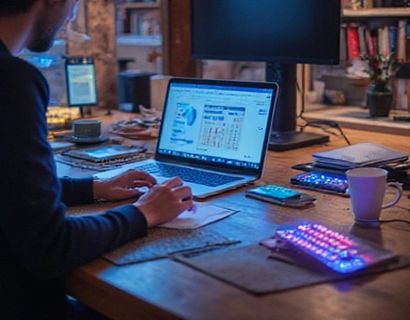Real-Time Multi-Chain Block Notifications: Empowering Cryptocurrency Investors with Advanced Blockchain Alerts
In the rapidly evolving world of cryptocurrency, staying ahead of the curve is crucial for any investor or enthusiast. The decentralized nature of blockchain technology brings both opportunities and challenges, particularly in the realm of timing and information. Traditional methods of monitoring blockchain activity can be cumbersome and often result in delayed decisions, which can be detrimental in a market that moves at the speed of light. This is where real-time multi-chain block notifications come into play, offering a revolutionary solution to stay informed and make strategic investment decisions.
Real-time notifications across multiple blockchains provide instant updates on block minings, allowing users to react swiftly to market changes. These notifications are not just about being informed; they are about having the edge that can mean the difference between profit and loss. By leveraging advanced blockchain alerts, investors can monitor various chains simultaneously, ensuring they are always up-to-date with the latest developments.
Understanding Blockchain Alerts
Blockchain alerts are notifications triggered by specific events on a blockchain, such as the mining of a new block. These events can include transaction confirmations, smart contract executions, and block height reachings. The key advantage of real-time alerts is their immediacy, providing users with the latest information as soon as it occurs.
Traditional alert systems often rely on periodic checks or manual monitoring, which can lead to missed opportunities. Real-time alerts, on the other hand, use sophisticated algorithms and APIs to detect and notify users of significant blockchain events instantly. This ensures that investors are always in the loop, regardless of the time of day or the number of blockchains they are monitoring.
Benefits of Real-Time Multi-Chain Block Notifications
The benefits of real-time multi-chain block notifications are numerous and significant. First and foremost, they enhance decision-making by providing timely data. In a market where seconds can make a difference, having immediate access to block mining notifications can help investors capitalize on emerging trends and opportunities.
Another key benefit is the reduction of information asymmetry. By receiving real-time alerts, investors can stay informed about events that might not be immediately visible on major exchanges or news outlets. This level of access to information can be a significant advantage, especially in high-stakes trading environments.
Real-time notifications also improve risk management. By being alerted to block minings, investors can quickly assess the impact of new blocks on market dynamics, such as changes in supply and demand, price movements, and potential security issues. This proactive approach to risk management can help mitigate losses and maximize gains.
Technical Implementation of Real-Time Blockchain Alerts
Implementing a real-time blockchain alert system involves several technical components. At the core, these systems use blockchain APIs to connect to various chains and monitor block events. These APIs provide access to real-time data streams, which are then processed and formatted into notifications.
The first step is to select the blockchains to monitor. This can include major chains like Bitcoin, Ethereum, and Binance Coin, as well as lesser-known but potentially lucrative altcoins. Each blockchain has its unique characteristics and events that can trigger alerts, such as Ethereum's EIP-1559 gas price updates or Binance Coin's decentralized finance (DeFi) smart contracts.
Once the blockchains are selected, the system uses blockchain explorers and nodes to fetch data. These explorers provide a user-friendly interface to access blockchain information, while nodes ensure the system has direct access to the blockchain's ledger. The data is then analyzed using custom algorithms to identify significant events, such as the mining of a new block or the execution of a smart contract.
After identifying these events, the system generates notifications. These can be sent via various channels, including email, SMS, push notifications on mobile devices, and webhooks for integration with trading platforms. The choice of notification method depends on the user's preferences and the specific use case.
Customization and Flexibility
One of the most appealing aspects of real-time multi-chain block notifications is their customization. Users can tailor the alerts to their specific needs, selecting which blockchains to monitor, which events to trigger notifications for, and the frequency of updates. This level of flexibility ensures that the alert system is as useful and relevant as possible for each individual investor.
For instance, a day trader might be interested in real-time alerts for major blockchains like Bitcoin and Ethereum, focusing on block height and transaction confirmations. In contrast, a long-term investor might prefer alerts for lesser-known blockchains that are gaining traction, such as Solana or Polkadot, with an emphasis on smart contract deployments and governance proposals.
Additionally, users can set thresholds and conditions for alerts. For example, they can receive notifications only when a block reaches a certain height or when a specific number of transactions occur within a block. This granular control helps filter out noise and focus on the most relevant events.
Integration with Trading Platforms
Real-time blockchain alerts can be seamlessly integrated with popular trading platforms, enhancing the overall trading experience. By connecting alert systems to trading interfaces, investors can automate their responses to block mining events. For example, an alert for a new block on Ethereum could automatically execute a buy or sell order based on predefined criteria.
This integration not only saves time but also reduces the risk of human error. Automated trading based on real-time alerts ensures that decisions are made based on the most current data, rather than delayed or manual processes. This automation is particularly valuable in high-frequency trading, where every second counts.
Case Studies and Real-World Applications
To illustrate the practical benefits of real-time multi-chain block notifications, consider a few real-world scenarios. In one case, a trader monitoring multiple blockchains received an alert about a new block on Ethereum that included a significant number of decentralized finance (DeFi) transactions. Recognizing the potential impact on liquidity and gas prices, the trader adjusted their positions accordingly, capitalizing on the resulting market movements.
Another example involves a portfolio manager who uses real-time alerts to stay informed about governance proposals on various blockchains. When a proposal on Polkadot gains enough support to be executed, the manager receives an immediate notification. This allows them to assess the potential implications for the blockchain's ecosystem and adjust their investment strategy in real time.
These case studies demonstrate how real-time blockchain alerts can provide actionable insights, enabling investors to make informed and timely decisions. The ability to react quickly to blockchain events can be a significant competitive advantage in the fast-paced cryptocurrency market.
Challenges and Considerations
While the benefits of real-time multi-chain block notifications are clear, there are also challenges and considerations to keep in mind. One of the primary challenges is the sheer volume of data generated by multiple blockchains. Ensuring that the alert system can handle this data efficiently without overwhelming the user is crucial.
Another consideration is the accuracy and reliability of the alerts. Blockchain data can sometimes be inconsistent or delayed, especially for lesser-known blockchains. To mitigate this, it is essential to use reputable blockchain explorers and nodes and to implement robust data validation mechanisms.
Privacy and security are also important factors. Real-time alert systems must ensure that user data is protected and that notifications are secure. This includes using encryption for data transmission and storage, as well as implementing strict access controls.
Future Trends and Innovations
The landscape of real-time blockchain notifications is continually evolving, with new technologies and innovations on the horizon. One promising area is the integration of artificial intelligence (AI) and machine learning (ML) to enhance alert systems. AI can help filter and prioritize alerts based on historical data and predictive analytics, reducing false positives and providing more actionable insights.
Another trend is the development of cross-chain alert systems that can monitor multiple blockchains simultaneously, providing a unified view of the cryptocurrency market. This would eliminate the need to manage multiple alert sources and offer a more comprehensive monitoring solution.
Furthermore, the rise of layer 2 solutions and interoperability protocols like Polkadot and Cosmos is creating new opportunities for real-time notifications. As these technologies mature, alert systems will need to adapt to monitor events across interconnected blockchains, offering even more value to investors.
Conclusion
Real-time multi-chain block notifications represent a significant advancement in the tools available to cryptocurrency investors. By providing instant, accurate, and comprehensive alerts, these systems empower users to make informed and timely decisions in a dynamic market. Whether you are a day trader, a portfolio manager, or a blockchain enthusiast, integrating real-time blockchain alerts into your investment strategy can provide a competitive edge and enhance your overall trading experience.
As the cryptocurrency landscape continues to evolve, the importance of staying informed through real-time notifications will only grow. Embracing these advanced alert systems is not just a choice; it's a necessity for anyone serious about succeeding in the world of digital currencies.











































